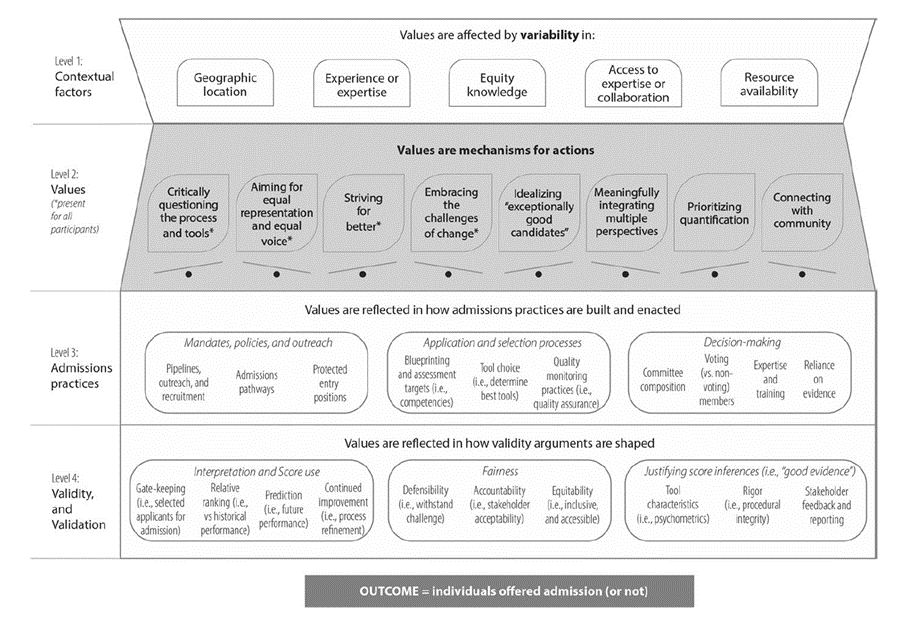#43 – Getting In to Medical School: What Counts? And Why?
Episode host: Jonathan Sherbino.

(Photo E. Cronberg).
Episode article
Young, M. E., Shankar, S., & St-Onge, C. (2023). “An exploration of values in medical school admissions processes: The interplay between contextual factors, admissions practices, and validity”, Advances in Health Sciences Education.
Medical school admission is a complex process. But what is a driver of these processes? This study explores the implicit and explicit values of Canadian medical schools about what and how (and how to monitor) an admission system runs.
Episode notes
Background
Admission to health professional education training programs is an incredibly stressful process for applicants. But you’re not listening to this podcast to hear obvious conclusions. Listener, you have probably already lived this experience in so way – including graduate school if you are not a health professional.
On the surface, it seems that content (data about the candidate) and process (how the data is used for selection) defines medical school admissions. More recently, validity evidence (i.e. theoretical and empirical proofs that the scoring, generalization, extrapolation, and implications support the assumptions of the system) has been an important concept in rigorous admission systems. However, this “objective” presentation misses a hidden, but central driver, – “what is valued in the admission system?”
Before we can consider issues of professional identity, or discuss issues of equity in HPE, we need to understand how the system is set-up, and the tacit and unconscious beliefs that an admission system stands on. Enter Young et al.,
Purpose
From the authors:
…we use data generated through interviews with those responsible for designing and monitoring admissions processes to explore the values at play in medical school admissions processes, quality monitoring practices, and the corresponding standards of excellenc
(Young et al., 2023)
Methods
The authors used phenomenography, which is a qualitative research methodology that explores the diverse ways individuals understand, experience, and conceptualize various ideas. It aims to map the range of possible understandings that exist within a particular group, rather than focusing on quantifying these. This approach is particularly interested in the variation in people’s experiences and the different meanings they ascribe to their experiences.
Phenomenography produces conceptions that provide a broad map of the potential landscape, unlike themes that imbed aggregate experience to describe the central/dominant perception(s) of the group.
Current (or immediate past) leaders of admission programs for all Canadian medical schools were contacted. Semi-structured interviews (in French or English) were conducted. Iterative coding resulted in a categorization of similar codes that led to a common value. An outcome space (i.e., an organized description of the conceptions/values and their interrelations.) completed the analysis.
Results/Findings
There were ten participants (representing 10/17 Candian medical schools).
Only one participant had specific admissions role training with the majority acquiring knowledge of the process through experience.
The outcome space is reproduced here:

The hierarchical arrangement shows relational connections. Weighting of values is not equal for individual school processes. The impact of the values “trickles” down to admission practices, and in turn influences the implications and consequences (validation) of the admission process. In sum, all of these factors lead to a single outcome – an offer of admission ( or not).
Of note, all participants proivded data that aligned with 5 of the values, showing the intersection of values.
Conclusions
“This study documents various values that influence admissions processes… The values that shape what…how…and how fair and defensible practices are conceptualized have significant impact, ultimately determining who is selected. These values… result in intended and unintended consequences in selection processes. However, these values are rarely explicitly examined and questioned, leaving it uncertain as to which consequences are the intended outcomes of deliberately chosen values, and which are unintended consequences of implicitly held values of admissions systems and their actors.
(Young et al, 2023)
Paperclips
The writing style of this manuscript is “lovely.” The chain of logic (ok, conceptual framework Varpio… ugh, enough) in the introduction is concise, clear and explicit in it’s argument. Also, the subsection on how the authors introduce rigor into their study should be cut and pasted into all research methods courses.

0 comments